Students can download 10th Science Chapter 13 Structural Organisation of Animals Questions and Answers, Notes, Samacheer Kalvi 10th Science Guide Pdf helps you to revise the complete Tamilnadu State Board New Syllabus, helps students complete homework assignments and to score high marks in board exams.
Tamilnadu Samacheer Kalvi 10th Science Solutions Chapter 13 Structural Organisation of Animals
Samacheer Kalvi 10th Science Structural Organisation of Animals Text Book Back Questions and Answers
I. Choose the best answer:
Question 1.
In leech locomotion is performed by:
(a) Anterior sucker
(b) Posterior sucker
(c) Setae
(d) None of the above
Answer:
(a) Anterior sucker
Question 2.
The segments of leech are known as _____.
(a) Metameres (somites)
(b) Proglottids
(c) Strobila
(d) All the above.
Answer:
(a) Metameres (somites).
![]()
Question 3.
Pharyngeal ganglion in leech is a part of:
(a) Excretory system
(b) Nervous system
(c) Reproductive system
(d) Respiratory system
Answer:
(b) Nervous system
Question 4.
The brain of leech lies above, the _____.
(a) Mouth
(b) Buccal Cavity
(c) Pharynx
(d) Crop.
Answer:
(c) Pharynx
Question 5.
The body of leech has:
(a) 23 segments
(b) 33 segments
(c) 38 segments
(d) 30 segments
Answer:
(b) 33 segments
Question 6.
Mammals are animals.
(a) Cold blooded
(b) Warm blooded
(c) Poikilothermic
(d) All the above
Answer:
(b) Warm blooded
Question 7.
The animals which give birth to young ones are _____.
(a) Oviparous
(b) Viviparous
(c) Ovoviviparous
(d) All the above.
Answer:
(d) All the above
II. Fill in the blanks:
- The posterior sucker is formed by the fusion of the ………. segments.
- The existence of two sets of teeth in the life of an animal is called ……….. dentition.
- The anterior end of leech has a lobe-like structure called ………..
- The blood sucking habit of leech is known as ………..
- ………. separate nitrogenous waste from the blood in rabbit.
- ……… spinal nerves are present in rabbit.
Answer:
- last seven
- diphyodont
- anterior sucker
- sanguivorous
- Nephrons (kidney)
- 37 pair
![]()
III. Identify whether the statements are True or False. Correct the false statement:
- An anticoagulant present in saliva of leech is called heparin.
- The vas deferens serves to transport the ovum.
- The rabbit has a third eyelid called tympanic membrane which is movable.
- Diastema is a gap between premolar and molar teeth in rabbit.
- The cerebral hemispheres of rabbit are connected by band of nerve tissue called corpora quadrigemina.
Answer:
- True
- False – Vas deferens serves to transport the sperm.
- True
- False – The gap between the incisors and premolars.
- False – The cerebral hemispheres of rabbit are connected by band of nerve tissue called corpora corpus callosum.
IV. Match columns I, II and III correctly:
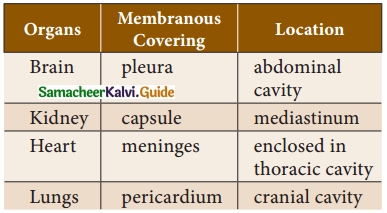
Answer:

V. Answer in a sentence:
Question 1.
Give the common name of the Hirudinaria granulosa.
Answer:
The common name of Hirundinaria granulosa is Indian Cattle Leech.
Question 2.
How does leech respire?
Answer:
Leech respire through the skin.
Question 3.
Write the dental formula of rabbit.
Answer:
The dental formula of rabbit is \(\frac{2033}{1023}\)
Question 4.
How many pairs of testes are present in leech?
Answer:
There are 11 pairs of testes are present in Leech.
Question 5.
How is diastema formed in rabbit?
Answer:
Diastema is due to the absence of canine. It is a gap between incisors and premolars in the upper jaw and lower jaw.
![]()
Question 6.
What organs are attached to the two bronchi?
Answer:
The organs attached to the two bronchi are lungs.
Question 7.
Which organ acts as a suction pump in leech?
Answer:
The Pharynx acts as a suction pump in Leech.
Question 8.
What does CNS stand for?
Answer:
The full form of CNS is Central Nervous System.
Question 9.
Why is the teeth of rabbit called heterodont?
Answer:
The dentition of rabbit is called heterodont, as they have different types of teeth (Incisors, premolars and molars).
Question 10.
How does leech suck blood from the host?
Answer:
The Anterior sucker helps in feeding, while both the suckers, help in attachment and locomotion.
VI. Short answer questions:
Question 1.
Why are the rings of cartilages found in trachea of rabbit?
Answer:
The wall of larynx which serves as the voice box is supported by 4 cartilaginous plates. When the air passes the vocal cord, it vibrates resulting in sound production.
Question 2.
List out the parasitic adaptations in the leech.
Answer:
Leeches lead a parasitic mode of life, by sucking the blood of vertebrates. The adaptations are
- Blood is sucked by the pharynx.
- Anterior and Posterior Suckers are provided, by which the animal attaches itself to the body of the host.
- The three Jaws, inside the mouth, causes a painless Y – shaped wound in the skin of the host,
- The salivary glands produce Hirudin, which does not allow the blood to coagulate. So, the continuous supply of blood is maintained.
- Parapodia and Setae are absent.
- Blood is stored in the crop. It gives nourishment to the leech for several months. So there is no elaborate secretion of the digestive juices and enzymes.
VII. Long answer questions:
Question 1.
How is the circulatory system designed in leech to compensate the heart structure?
Answer:
The circulation in Leech is Haemocoelic system. There are no true blood vessels. The blood vessels are replaced by channels called Haemocoelic channels or canals, filled with blood like a fluid. The coelomic fluid contains Haemoglobin.
There are four longitudinal channels. One channel lies above (dorsal) to the Alimentary canal, one below (ventral) to the Alimentary canal. The other two channels lie on either (lateral) side of the Alimentary canal, which serves as a heart and have inner valves. All the four channels are connected together posteriorly in the 26th segment. Thus the circulatory system is designed in Leech to compensate the heart structure.
Question 2.
How does locomotion take place in leech?
Answer:
- Looping or Crawling movement : Looping movement is brought about by the contraction and relaxation of muscles. The two suckers serve for attachment during movement. The animal fixes its posterior sucker on the substratum.
- Swimming movement : The animal swims in the water by undulating movements of the body.
Question 3.
Explain the male reproductive system of rabbit with a labelled diagram.
Answer:
The male rabbit has a pair of testes. They are oval in shape. They are kept in two sacs called scrotal sacs hanging down from the abdomen. Each testes is formed of numerous fine tubules called seminiferous tubules. A coiled tubule called epididymis is formed at the end of seminiferous tubules. Epididymis lead into the sperm duct called vas deferens. The vas deferens run forward and enters abdominal cavity through urinary bladder. The urethra runs back and passes into the penis. There are three accessory glands associated with the male reproductive system. They are prostate glands, cowper’s gland and perineal glands. Their secretion nourishes and activates the reproduction.
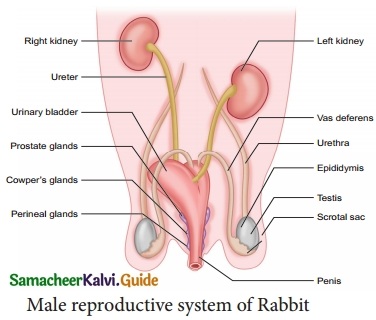
![]()
VIII. Higher Order Thinking Skills (HOTS).
Question 1.
Arjun is studying in the tenth standard. He was down with fever and went to meet the doctor. As he went to the clinic he saw a patient undergoing treatment for severe leech bite. Being curious, Arjun asked the doctor why leech bite was not felt as soon as it attaches to the skin? What would have been the reply given by the doctor?
Answer:
The doctors would have replied that the leeches inject an anaesthetic substance, that prevents the host from feeling their bite.
Question 2.
Shylesh has some pet animals at his home. He has few rabbits too, one day while feeding them he observed something different with the teeth. He asked his grandfather, why is it so? What would have been the explanation of his grandfather?
Answer:
The rabbit has three types of teeth – Incisors are front teeth used for cutting, premolar and molar are used for grinding. Canine is absent as rabbit are herbivores. The gap between the incisor and premolar is called diastema. It helps in mastication and chewing of food in herbivores animal.
IX. Value-Based Questions:
Question 1.
Leeches do not have an elaborate secretion of digestive juices and enzymes. Why?
Answer:
The digestion in leeches in very slow. So, the blood stored in the crop gives nourishment to the leech for several months. So there is not elaborate secretion of digestive juices and enzymes.
Question 2.
How is the digestive system of rabbit suited for herbivorous mode of feeding?
Answer:
Rabbit are herbivores which feed on plants. The plant contain cellulose which need cellulose to digest. The laccum of Rabbit contain large number of symbiotic bacteria that helps in digestion of cellulose.
![]()
Samacheer Kalvi 10th Science Structural Organisation of Animals Additional Important Questions and Answers
I. Choose the correct answer:
Question 1.
(a) Vas deferens and Epididymis
(b) Ovary and Caeca
(c) Hirudin and Stomach
(d) Nephridia and Papillae.
Answer:
(a) Vas deferens and Epididymis
Question 2.
Diastema is:
(a) A part of pelvic girdle in rabbit
(b) A type of tooth in rabbit
(c) Space in teeth line in mammals
(d) Structure in eye of rabbit
Answer:
(c) Space in teeth line in mammals
Question 3.
(a) Suckers and Mammary glands
(b) Cowper’s gland and Perineal gland
(c) Forebrain and Oesophagus
(d) Cellulose and Colouration.
Answer:
(b) Cowper’s gland and Perineal gland
Question 4.
If the dental formula of rabbit is \(\frac{2023}{1023}\) What does it show?
(a) Total number of teeth in Rabbit is 15
(b) Number of total incisors in Rabbit is 3
(c) Diastema is present between incisors and premolars
(d) In the formula 2033 is for adult and 1023 is for young ones
Answer:
(c) Diastema is present between incisors and premolars
Question 5.
Number of pairs of salivary glands present in Rabbit is:
(a) one
(b) three
(c) four
(d) five
Answer:
(c) four
Question 6.
Number of Vertebrae in rabbit is:
(a) 44 – 47
(b) 40 – 44
(c) 42 – 48
(d) 47 – 50
Answer:
(a) 44 – 47
Question 7.
If the diaphragm of a rabbit is perforated breathing is:
(a) Not affected
(b) Increased
(c) Decreased
(d) Stopped
Answer:
(d) Stopped
![]()
Question 8.
Tracheal rings in rabbit are:
(a) complete
(b) dorsally incomplete
(c) lateral incomplete
(d) incomplete
Answer:
(b) dorsally incomplete
Question 9.
Which one of the following is not a characteristic of leech?
(a) closed circulatory system
(b) segmentation
(c) pseudo coelom
(d) ventral nerve cord
Answer:
(c) pseudo coelom
Question 10.
The blood vascular system, of rabbit is:
(a) open type
(b) closed type
(c) semi closed type
(d) semi open type
Answer:
(b) closed type
Question 11.
The wall of Rabbit’s heart is thick due to the presence of:
(a) Inner layer endocardium
(b) Middle layer myocardium
(c) Outer layer pericardium
(d) Outer layer epicardium
Answer:
(b) Middle layer myocardium
Question 12.
Leech belongs to the class:
(a) polychaeta
(b) oligochaeta
(c) hirundinea
(d) archiannelida
Answer:
(c) hirundinea
Question 13.
A temporary clitellum occur during the breeding season in:
(a) Pheretima
(b) Heteroneris
(c) Hirundinaria
(d) Aphrodile
Answer:
(c) Hirundinaria
Question 14.
Saliva of leeches contains an anti coagulation called:
(a) Heparin
(b) Histamine
(c) Hirudin
(d) Haematin
Answer:
(c) Hirudin
II. Fill in the blanks:
1. Hirudinaria granulosa belong to the phylum ……..
2. The scientific name of the rabbit is ………
3. ………. is the segmentation of the body.
4. The type of movement is brought by the contraction and relaxation of muscles in leeches is ………
5. In leech, the digestion takes place in stomach by the action of …………
6. The ……….. prevents the entry of food into the trachea through the glottis.
7. The existence of two sets of teeth in the life of an animal is called ………… dentition.
8. ……….. contains bacteria that helps in digestion of cellulose.
9. The anterior part of the oviduct in rabbit is …………
10. Breathing movement in mammals are brought by ………..
Answer:
1. Annelida
2. Oryctolagus cuniculus
3. Metamerism
4. Looping or crawling movement
5. Proteolytic enzyme
6. Epiglottis
7. Diphyodont
8. Caecum
9. Fallopian tube
10. Diaphragm
![]()
III. Identify whether the statements are True or False. Correct the false statement:
- Mammary gland in male is the most striking feature of mammals.
- The leech makes a triradiate or y-shaped incision in the skin of the host by the joins protrude through the mouth.
- Crop and its diverticular in leech can store large amount of blood which can be slowly digested.
- Breathing movement in Rabbit are brought by the movement of vibrissae.
- In rabbit pair of cowper’s gland and perineal gland are present only in the male.
Answer:
- False – Mammary gland in female is the most striking feature of mammals.
- True
- True
- False – Breathing movement in Rabbit are brought by Diaphragm
- False – In rabbit pair of cowper’s gland and perineal gland are present both male and female
IV. Match the following:
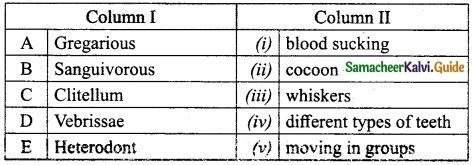
Answer:
A. (v)
B. (i)
C. (ii)
D. (iii)
E. (iv)
V. Answer in a sentence:
Question 1.
Name the excretory organ of leech.
Answer:
Excretion in leech takes place by nephridia.
Question 2.
Give the Scientific name of Rabbit.
Answer:
Oryctolagus Cuniculus.
Question 3.
Where is the brain of rabbit located?
Answer:
The brain of rabbit is located in the cranial cavity and covered by three membrane of duramater, piamater and arachnoid membrane.
Question 4.
How many pairs of cranial nerves are there in the Peripheral Nervous System?
Answer:
12 pairs of cranial nerves.
Question 5.
What is other name of whiskers in rabbit?
Answer:
The sides of the upper lip produce stiff long thick hairs called vibrissae or whisker which are tactile sensory organ.
![]()
Question 6.
Which type of rabbit are endangered species?
Answer:
Pygmy Rabbits are listed as an endangered species.
Question 7.
Name the existence of two sets of teeth in the life of an animal.
Answer:
Diphyodont dentition
Question 8.
Why Rabbits are called gregarious animals?
Answer:
Rabbits are called gregarious animals as they move in group.
Question 9.
Which animals are called sanguivorous?
Answer:
Blood sucking animals.
Question 10.
What are nephridropores?
Answer:
In leech, excretion takes place by segmentally arranged paired tubules called nephridia. There are 17 pairs of nephridia which open by nephridiopores from 6th to 22nd segment.
VI. Short Answer Questions:
Question 1.
Write the systematic position of Indian Cattle Leech.
Answer:
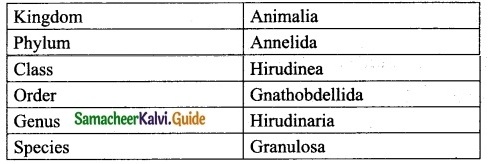
Question 2.
What do you know about the Trunk of Rabbit?
Answer:
The trunk is divisible into an anterior thorax and a posterior abdomen. In females, four or five teats or nipples are present on the ventral surface between Thorax and abdomen. The trunk has two pairs of Pentadactyl limbs. The forelimbs are shorter than the hind limbs.
All the digits bear claws. The anus is present at the posterior end. In females, on the ventral side, a slit-like Vulva is present. In males, the Penis is present in the ventral side of Anus. The male has a pair of testes, enclosed by Scrotal Sacs.
![]()
Question 3.
How do the leeches respire?
Answer:
There is no special respiration organ in leech. The skin serves as a respiratory i organ. The capillaries containing the haemocoelomic fluid extend in between the cells of the epidermis, acts as a permeable membrane through which the exchange of gases takes place by diffusion.
Question 4.
What are diphyodont dentition and Heterodont dentition?
Answer:
The existence of two sets of teeth in the life of an animal is called diphyodont dentition. The two types of teeth are Milk teeth (Young ones) and Permanent teeth (in adults).
The different types of dentition are called Heterodont. There are four kinds of teeth in mammals.
The incisors (I), Canines (C), Premolars (PM) and Molars (M).
Question 5.
List out the five layers of body wall of Leech.
Answer:
The body wall of leech consists of five layers.
- Cuticle
- Epidermis
- Dermis
- Muscular layer and
- Botryoidal tissue
Question 6.
Give the systematic position of Rabbit.
Answer:
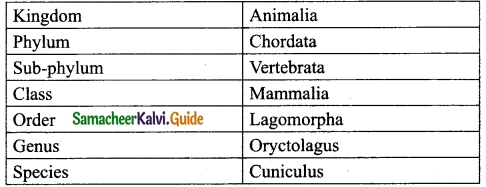
Question 7.
Explain the Respiratory system of Leech.
Answer:
Respiration takes place through the skin in Leech. Dense, network to tiny blood vessels called Capillaries, containing haemocoel fluid extend, in between the cells of the epidermis. The exchange of respiratory gases takes place by diffusion. Oxygen dissolved in water diffuses through the skin, into haemocoel fluid, while Carbon dioxide, diffuses out. The skin is kept moist and slimy, due to the secretion of mucus, which prevents the skin from drying.
Question 8.
List out the steps involved in Inspiration in Rabbit.
Answer:
During Inspiration the atmospheric air takes the following route.
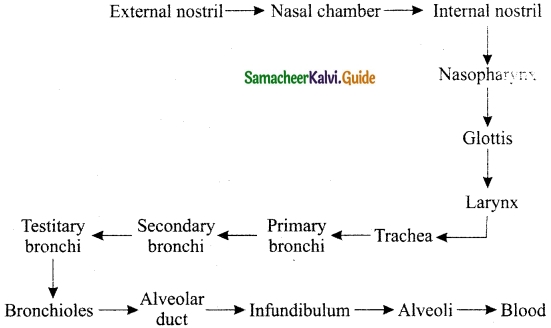
VII. Long answer questions:
Question 1.
Compare the digestive system of Leech and Rabbit.
Answer:
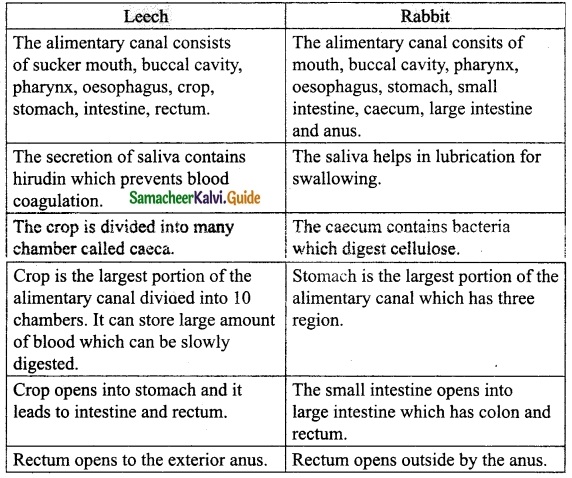
![]()
Question 2.
Short notes on the Nervous System of Leech.
Answer:
The Central Nervous System of Leech consists of a nerve ring and a paired ventral nerve cord. The nerve ring surrounds the Pharynx and is formed of Suprapharyngeal ganglion (brain), Circum pharyngeal connective and Subpharyngeal ganglion. The Subpharyngeal ganglion lies below the Pharynx and is formed by the fusion of four pairs of Ganglia.